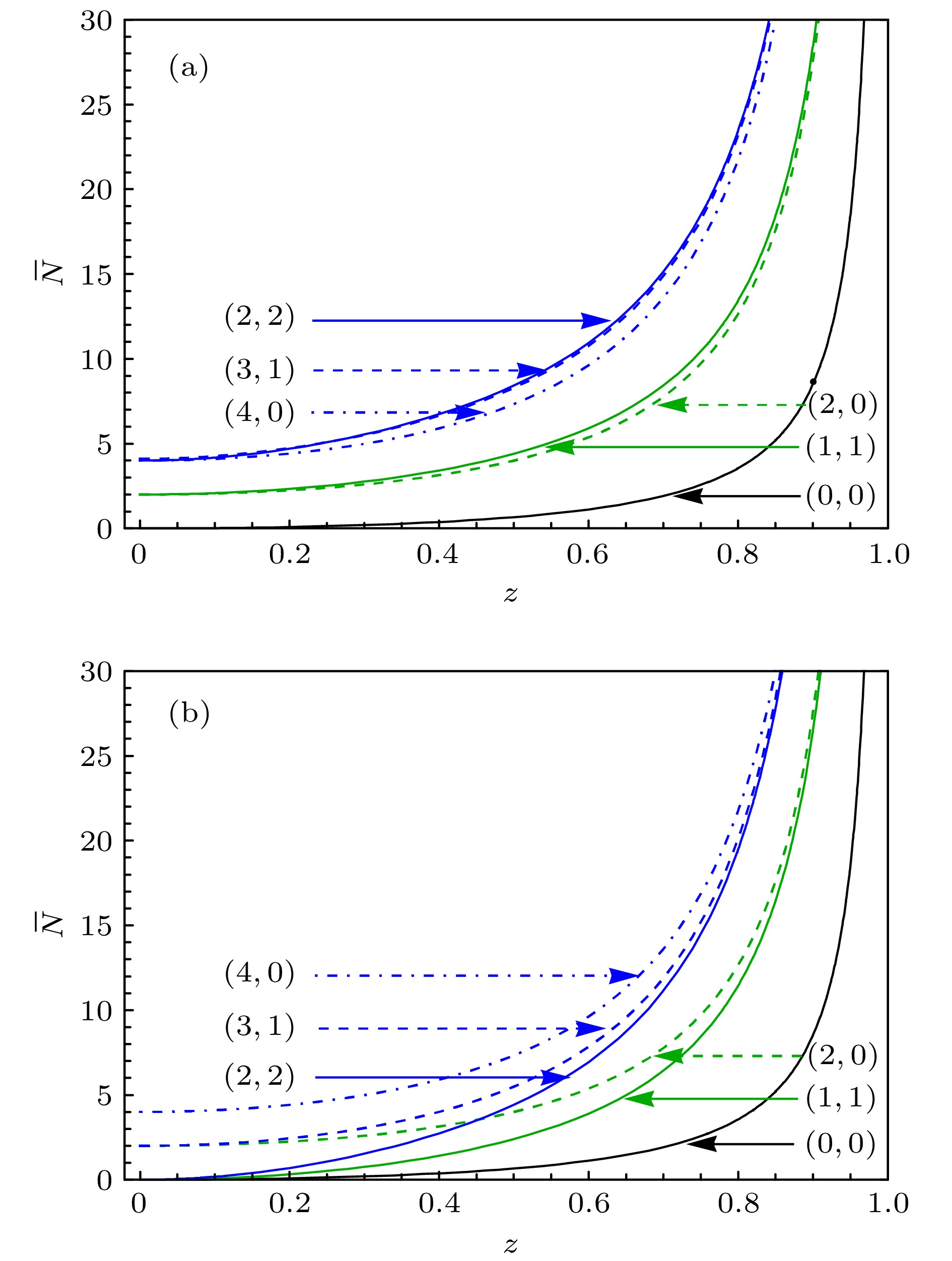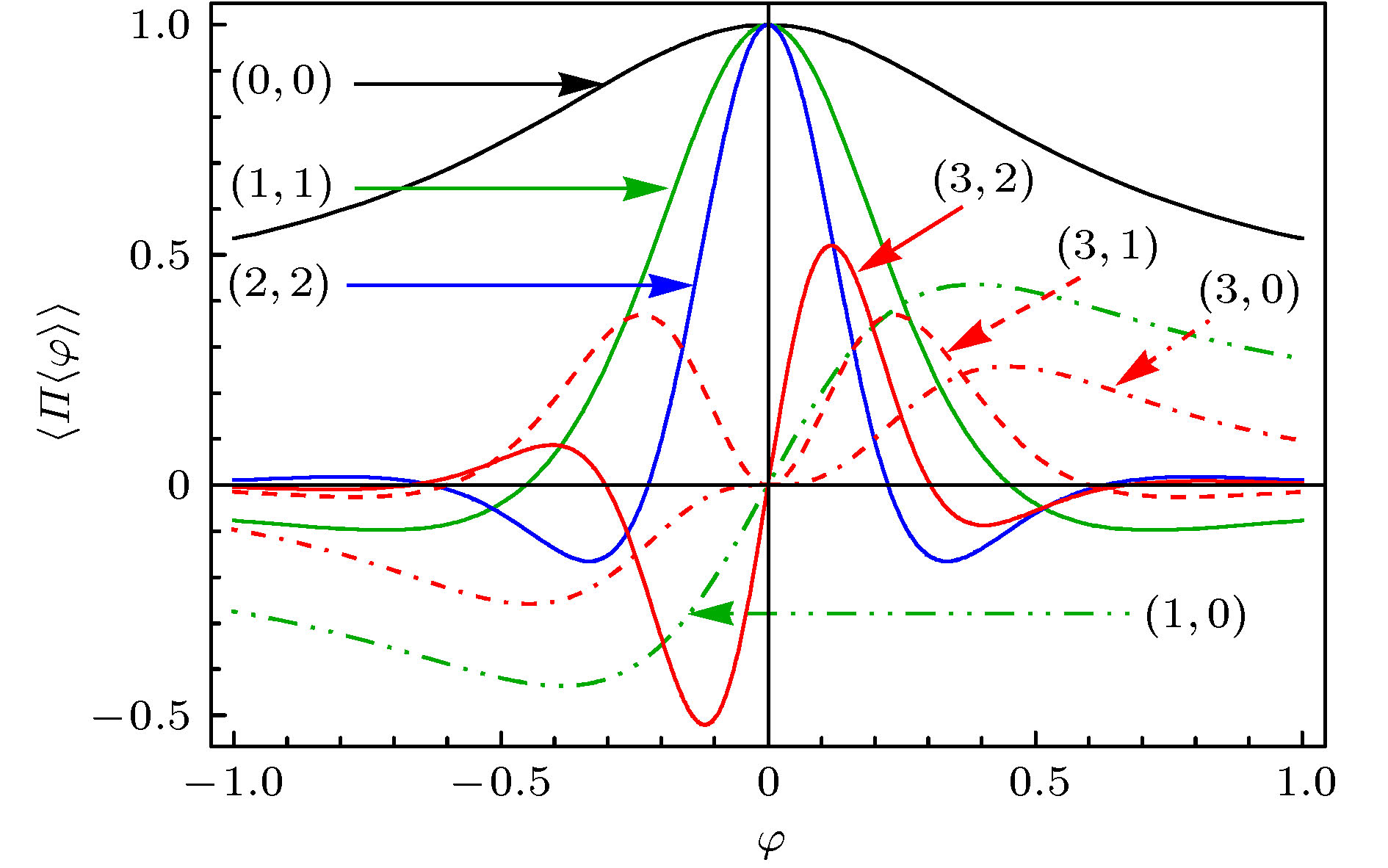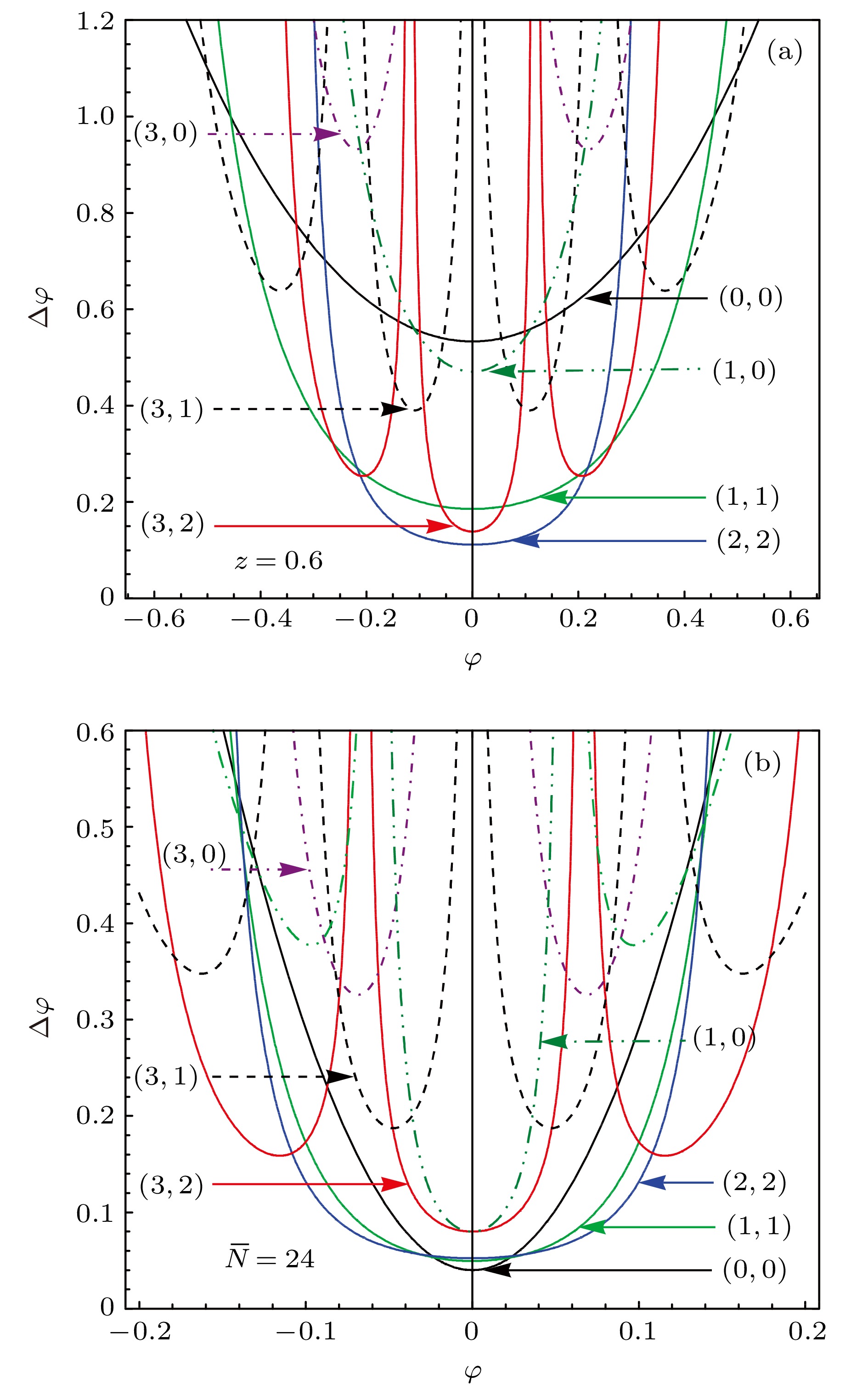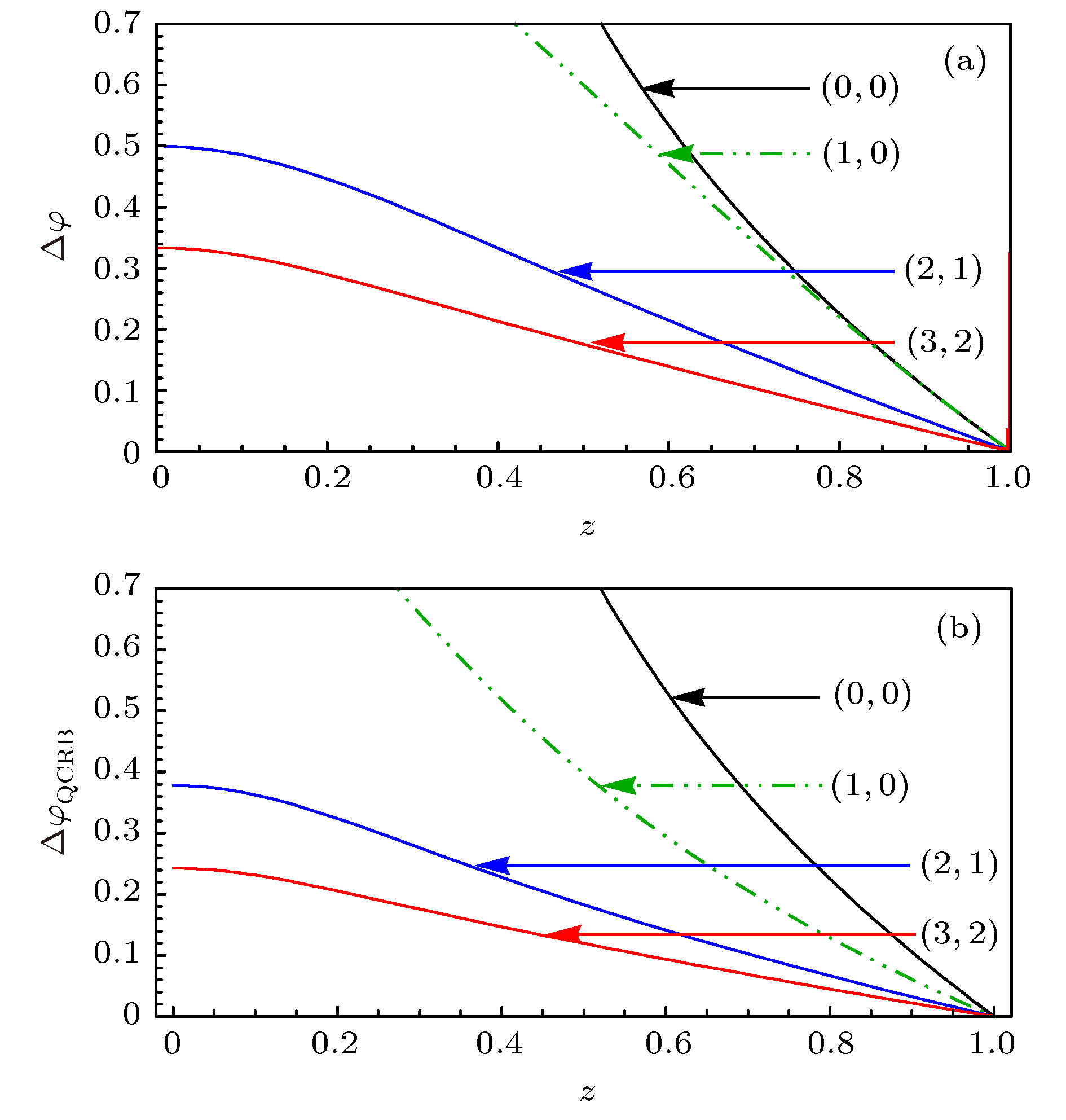-
量子度量学主要是利用量子效应来提高参数估计的精度, 以期突破标准量子极限, 甚至达到海森伯极限. 本文研究了一般光子增加双模压缩真空态作为马赫-曾德尔干涉仪的探测态时, 在何种情况下能够提高待测相位的测量精度. 根据量子Fisher信息理论, 尽管在探测态具有相同的平均光子数这一约束条件下, 对称的和非对称的光子增加操作并不能提高相位的测量精度. 但若是在给定初始压缩参数的情况下, 对称的和非对称的光子增加操作却能够增强相位的测量精度. 另外, 基于宇称测量的研究结果表明, 对于对称光子增加双模压缩真空态, 只有当待测相位趋于零时, 宇称测量才是最优测量. 而对于非对称光子增加双模压缩真空态, 宇称测量并不是最优测量方案.Quantum metrology is to estimate accurately the value of an unknown parameter with the assistance of the quantum effects, in order to break through the standard quantum limit, even reach the Heisenberg limit. In this work, we study the performance of a general photon-added two-mode squeezed vacuum state that is taken as a detection state of a Mach-Zehnder interferometer. Based on quantum Fisher information, within the constraint on the total mean photon number, symmetric and asymmetric photon addition cannot improve the ultimate phase sensitivity. However, for a given initial squeezing parameter, on this occasion, the symmetric and asymmetric photon addition can improve the ultimate phase sensitivity. Compared with the asymmetric photon-added two-mode squeezed vacuum state, the symmetric one can well improve the ultimate phase sensitivity. This may be because it is always better to implement the symmetric photon addition rather than the asymmetric one in order to increase the mean photon number of the resulting state. On the other hand, via parity detection, the symmetric and asymmetric photon-added two-mode squeezed vacuum state can indeed improve the phase sensitivity of a Mach-Zehnder interferometer for a given initial squeezing parameter. Based on the parity detection, within a constraint on the mean photon number, although the two-mode squeezed vacuum state can give the better phase sensitivity at the optimal phase shift (φ = 0), the phase sensitivity offered by the symmetric and asymmetric photon-added two-mode squeezed vacuum states are both more stable around φ = 0 than by the two-mode squeezed vacuum state. In addition, we show that for the symmetric photon-added two-mode squeezed vacuum state, parity detection is an optimal detection only when the optimal phase shift approaches to zero. When the phase shift slightly deviates from zero, the parity detection is not an optimal detection scheme. Finally, for all values of the phase shift, our results also clearly show that the parity detection is not an optimal detection scheme for the asymmetric photon-added two-mode squeezed vacuum state serving as an interferometer state.
[1] Caves C M 1981 Phys. Rev. D 23 1693
 Google Scholar
Google Scholar
[2] Holland M J, Burnett K 1993 Phys. Rev. Lett. 71 1355
 Google Scholar
Google Scholar
[3] Campos R A, Gerry C C, Benmoussa A 2003 Phys. Rev. A 68 023810
 Google Scholar
Google Scholar
[4] Wang S, Wang Y T, Zhai L J, Zhang L J 2018 J. Opt. Soc. Am. B 35 1046
 Google Scholar
Google Scholar
[5] 王帅, 吴世臣, 眭永兴 2018 聊城大学学报 120 77
Wang S, Wu S C, Sui Y X 2018 Journal of Liaocheng University 120 77
[6] Dowling J P 2008 Contemp. Phys. 49 125
 Google Scholar
Google Scholar
[7] Joo J, Munro W J, Spiller T P 2011 Phys. Rev. Lett. 107 083601
 Google Scholar
Google Scholar
[8] Ou Z Y 1996 Phys. Rev. Lett. 77 2352
 Google Scholar
Google Scholar
[9] Wenger J, Tualle-Brouri R, Grangier P 2004 Phys. Rev.Lett. 92 153601
 Google Scholar
Google Scholar
[10] Zavatta A, Viciani S, Bellini M 2004 Science 306 660
 Google Scholar
Google Scholar
[11] Zavatta A, Parigi V, Bellini M 2007 Phys. Rev. A 75 052106
 Google Scholar
Google Scholar
[12] Gerrits T, Glancy S, Clement T S, Calkins B, Lita A E, Miller A J, Migdall A L, Nam S W, Mirin R P, Knill E 2010 Phys. Rev. A 82 031802(R)
 Google Scholar
Google Scholar
[13] León-Montiel R J, Magaña-Loaiza O S, Perez-Leija A, U’Ren A, Busch K, Lita A E, Nam S W, Gerrits T, Mirin R R 2018 Frontiers in Optics/Laser Science Washington, DC, USA, September 16–20, 2018 paper LM1B.6
[14] Magaña-Loaiza O S, León-Montiel R J, Perez-Leija A, U’Ren A B, You C, Busch K, Lita A E, Nam S W, Mirin R R, Gerrits T 2019 npj Quantum Inf. 5 80
[15] Dell’ Anno F, De Siena S, Illuminati F 2006 Phys. Rep. 428 53
[16] Kim M S, 2008 J. Phys. B: At. Mol. Opt. Phys. 41 133001
 Google Scholar
Google Scholar
[17] Wang S, Hou L L, Chen X F, Xu X F 2015 Phys. Rev. A 91 063832
 Google Scholar
Google Scholar
[18] Navarrete-Benlloch C, García-Patrón R, Shapiro J H, Cerf N J 2012 Phys. Rev. A 86 012328
[19] Liao Q, Guo Y, Huang D, Huang P, Zeng G H 2018 New J. Phys. 20 023015
 Google Scholar
Google Scholar
[20] Guo Y, Ye W, Zhong H, Liao Q 2019 Phys. Rev. A 99 032327
 Google Scholar
Google Scholar
[21] Carranza R, Gerry C C 2012 J. Opt. Soc. Am. B 29 2581
 Google Scholar
Google Scholar
[22] Birrittella R, Gerry C C 2014 J. Opt. Soc. Am. B 31 586
 Google Scholar
Google Scholar
[23] Gong Q K, Hu X L, Li D, Yuan C H, Ou Z Y, Zhang W 2017 Phys. Rev. A 96 033809
 Google Scholar
Google Scholar
[24] Guo L L, Yu Y F, Zhang Z M 2018 Opt. Express 26 29099
[25] Ouyang Y, Wang S, Zhang L 2016 J. Opt. Soc. Am. B 33 1373
 Google Scholar
Google Scholar
[26] Wang S, Xu X X, Xu Y J, Zhang L J 2019 Opt. Commun. 444 102
 Google Scholar
Google Scholar
[27] 鹿博, 韩成银, 庄敏, 柯勇惯, 黄嘉豪, 李朝红 2019 68 040306
 Google Scholar
Google Scholar
Lu B, Han C Y, Zhuang M, Ke Y G, Huang J H, Li C H 2019 Acta Phys. Sin. 68 040306
 Google Scholar
Google Scholar
[28] Gerry C C, Mimih J 2010 Contemp. Phys. 51 497
 Google Scholar
Google Scholar
[29] Lang M D, Caves C M 2013 Phys. Rev. Lett. 111 173601
 Google Scholar
Google Scholar
[30] Stephen M B, Gergely F, Claire R G, Fiona C S 2018 Phys. Rev. A 98 013809
 Google Scholar
Google Scholar
[31] Zhong W, Wang F, Zhou L, Xu P, Sheng Y B, 2020 Sci. China-Phys. Mech. Astron. 63 260312
 Google Scholar
Google Scholar
[32] Anisimov P M, Raterman G M, Chiruvelli A, Plick W N, Huver S D, Lee H, Dowling J P 2010 Phys. Rev. Lett. 104 103602
 Google Scholar
Google Scholar
[33] Eberle T, Händchen V, Schnabel R 2013 Opt. Express 21 11546
 Google Scholar
Google Scholar
[34] Gerry C C, Mimih J 2010 Phys. Rev. A 82 013831
 Google Scholar
Google Scholar
[35] Hou L L, Xue J Z, Sui Y X, Wang S 2019 Chin. Phys. B 28 094217
 Google Scholar
Google Scholar
[36] Hu L Y, Xu X X, Fan H Y 2010 J. Opt. Soc. Am. B 27 286
[37] Yurke B, McCall S L, Klauder J R 1986 Phys. Rev. A 33 4033
 Google Scholar
Google Scholar
[38] Braunstein S L, Caves C M 1994 Phys. Rev. Lett. 72 3439
 Google Scholar
Google Scholar
[39] Zhong W, Lu X M, Jing X X, Wang X G 2014 J. Phys. A: Math. Theor. 47 385304
 Google Scholar
Google Scholar
[40] Ben-Aryeh Y 2012 J. Opt. Soc. Am. B 29 2754
 Google Scholar
Google Scholar
[41] Tan Q S, Liao J Q, Wang X G, Nori F 2014 Phys. Rev. A 89 053822
 Google Scholar
Google Scholar
[42] Pezzé L, Smerzi A 2008 Phys. Rev. Lett. 100 073601
 Google Scholar
Google Scholar
[43] Seshadreesan K P, Kim S, Dowling J P, Lee H 2013 Phys. Rev. A 87 043833
 Google Scholar
Google Scholar
[44] Yu X D, Li W, Zhu S Y, Zhang J 2016 Chin. Phys. B 25 020304
 Google Scholar
Google Scholar
[45] Huang Z X, Motes K R, Anisimov P M, Dowling J P, Berry D W 2017 Phys. Rev. A 95 053837
 Google Scholar
Google Scholar
[46] Fan H Y, Ruan T N 1983 Commun. Theor. Phys. 2 1563
 Google Scholar
Google Scholar
[47] Hu L Y, Fan H Y 2008 J. Opt. Soc. Am. B 25 1955
 Google Scholar
Google Scholar
[48] Oh C, Lee S Y, Nha H, Jeong H 2017 Phys. Rev. A 96 062304
 Google Scholar
Google Scholar
[49] Steuernagel O, Scheel S 2004 J. Phys. B: Quantum Semicalss Opt. 6 S66
 Google Scholar
Google Scholar
-
图 1 当对双模压缩真空态增加或扣除不同的光子数(
$ k, l $ )时, 相应的非高斯态的平均光子数随压缩参数z的变化曲线 (a)光子增加双模压缩真空态; (b)光子扣除双模压缩真空态; 不同颜色类型的曲线表示不同的($ k, l $ )取值Fig. 1. Added to or subtracted from a two-mode squeezed vacuum state with different photon numbers (
$ k, l $ ), the mean photon number variation of these corresponding non-Gaussian states with the squeezed parameter z: (a) Photon-added two-mode squeezed vacuum state; (b) photon-subtracted two-mode squeezed vacuum state. Different color curves correspond to different values of ($ k, l $ ).图 2 相位测量精度的最终极限
$ \Delta \varphi _{\rm{QCRB}} $ 随压缩参数z的变化曲线 (a)光子增加双模压缩真空态; (b)光子扣除双模压缩真空态; 不同颜色类型的曲线表示对双模压缩真空态执行不同光子数($ k, l $ )的增加或扣除操作Fig. 2. Ultimate limit of the phase sensitivity
$ \Delta \varphi _{\rm{QCRB}} $ as a function of the squeezing parameter z : (a) The photon-added two-mode squeezed vacuum state; (b) the photon-subtracted two-mode squeezed vacuum state. Different color curves correspond to add to or subtract from a two-mode squeezed vacuum state with different photon numbers ($ k, l $ )图 3 相位测量精度的最终极限
$ \Delta \varphi _{\rm{QCRB}} $ 随平均光子数的变化曲线 (a)光子增加双模压缩真空态; (b)光子扣除双模压缩真空态; 不同颜色类型的曲线表示对双模压缩真空态执行不同光子数($ k, l $ )的增加或扣除操作; 最上面的黑色虚线表示SNL极限, 而下面的黑色虚线则表示HL极限Fig. 3. Ultimate limit variation of the phase sensitivity
$ \Delta \varphi _{\rm{QCRB}} $ with the mean photon number: (a) The photon-added two-mode squeezed vacuum state; (b) the photon-subtracted two-mode squeezed vacuum state. Different color curves correspond to add to or subtract from a two-mode squeezed vacuum state with different photon numbers ($ k, l $ ). The upper black dashed line denotes the SNL limit, while the below black dashed line represents the HL limit.图 5 对于光子增加双模压缩真空态作为干涉仪的探测态, 当(
$ k, l $ )取不同值时,$ \Delta \varphi $ 随待测相位$ \varphi $ 的变化 (a)给定初始压缩参数$ z = 0.6 $ ; (b)给定相同的平均光子数$ \bar{N} = 24 $ Fig. 5. Phase sensitivity
$ \Delta \varphi $ as a function of the phase shift$ \varphi $ for some values of ($ k, l $ ) when the photon-added two-mode squeezed vacuum state is considered as interferometer states: (a) For a given initial squeezing parameter$ z = 0.6 $ ; (b) for a given mean photon number$ \bar{N} = 24 $ .图 6 在
$ \varphi = 10^{-3} $ 时, 对于光子增加双模压缩真空态的($ k, l $ )不同取值, 相位测量精度$ \Delta \varphi $ 随平均光子数的变化曲线 (a)对称光子增加的情况($ k = l $ ); (b)非对称光子增加的情况($ k = l+1 $ ); 最上面的黑色虚线表示SNL极限, 下面的黑色虚线则表示HL极限Fig. 6. Plots of the phase sensitivity
$ \Delta \varphi $ as a function of the mean photon number of the photon-added two-mode squeezed vacuum state for some different values of ($ k, l $ ) at$ \varphi = 10^{-3} $ : (a) Symmetric photon-added two-mode squeezed vacuum state ($ k = l $ ); (b) asymmetric photon-added two-mode squeezed vacuum state ($ k = l+1 $ ). The upper black dashed line denotes the SNL limit, while the below black dashed line represents the HL limit.图 7
$ \varphi = 10^{-3} $ 和给定不同($ k, l $ )取值时, 相位测量精度随初始压缩参数z的变化 (a)基于宇称测量得到的相位测量精度; (b)基于量子Fisher信息得到的最终测量界限$ \Delta \varphi _{\rm{QCRB}} $ Fig. 7. Phase sensitivity as a function of the initial squeezing parameter z for different values of (
$ k, l $ ) at$ \varphi = 10^{-3} $ : (a) The phase sensitivity obtained by the parity detection; (b) the ultimate limit of phase sensitivity$ \Delta \varphi _{\rm{QCRB}} $ obtained by the quantum Fisher information. -
[1] Caves C M 1981 Phys. Rev. D 23 1693
 Google Scholar
Google Scholar
[2] Holland M J, Burnett K 1993 Phys. Rev. Lett. 71 1355
 Google Scholar
Google Scholar
[3] Campos R A, Gerry C C, Benmoussa A 2003 Phys. Rev. A 68 023810
 Google Scholar
Google Scholar
[4] Wang S, Wang Y T, Zhai L J, Zhang L J 2018 J. Opt. Soc. Am. B 35 1046
 Google Scholar
Google Scholar
[5] 王帅, 吴世臣, 眭永兴 2018 聊城大学学报 120 77
Wang S, Wu S C, Sui Y X 2018 Journal of Liaocheng University 120 77
[6] Dowling J P 2008 Contemp. Phys. 49 125
 Google Scholar
Google Scholar
[7] Joo J, Munro W J, Spiller T P 2011 Phys. Rev. Lett. 107 083601
 Google Scholar
Google Scholar
[8] Ou Z Y 1996 Phys. Rev. Lett. 77 2352
 Google Scholar
Google Scholar
[9] Wenger J, Tualle-Brouri R, Grangier P 2004 Phys. Rev.Lett. 92 153601
 Google Scholar
Google Scholar
[10] Zavatta A, Viciani S, Bellini M 2004 Science 306 660
 Google Scholar
Google Scholar
[11] Zavatta A, Parigi V, Bellini M 2007 Phys. Rev. A 75 052106
 Google Scholar
Google Scholar
[12] Gerrits T, Glancy S, Clement T S, Calkins B, Lita A E, Miller A J, Migdall A L, Nam S W, Mirin R P, Knill E 2010 Phys. Rev. A 82 031802(R)
 Google Scholar
Google Scholar
[13] León-Montiel R J, Magaña-Loaiza O S, Perez-Leija A, U’Ren A, Busch K, Lita A E, Nam S W, Gerrits T, Mirin R R 2018 Frontiers in Optics/Laser Science Washington, DC, USA, September 16–20, 2018 paper LM1B.6
[14] Magaña-Loaiza O S, León-Montiel R J, Perez-Leija A, U’Ren A B, You C, Busch K, Lita A E, Nam S W, Mirin R R, Gerrits T 2019 npj Quantum Inf. 5 80
[15] Dell’ Anno F, De Siena S, Illuminati F 2006 Phys. Rep. 428 53
[16] Kim M S, 2008 J. Phys. B: At. Mol. Opt. Phys. 41 133001
 Google Scholar
Google Scholar
[17] Wang S, Hou L L, Chen X F, Xu X F 2015 Phys. Rev. A 91 063832
 Google Scholar
Google Scholar
[18] Navarrete-Benlloch C, García-Patrón R, Shapiro J H, Cerf N J 2012 Phys. Rev. A 86 012328
[19] Liao Q, Guo Y, Huang D, Huang P, Zeng G H 2018 New J. Phys. 20 023015
 Google Scholar
Google Scholar
[20] Guo Y, Ye W, Zhong H, Liao Q 2019 Phys. Rev. A 99 032327
 Google Scholar
Google Scholar
[21] Carranza R, Gerry C C 2012 J. Opt. Soc. Am. B 29 2581
 Google Scholar
Google Scholar
[22] Birrittella R, Gerry C C 2014 J. Opt. Soc. Am. B 31 586
 Google Scholar
Google Scholar
[23] Gong Q K, Hu X L, Li D, Yuan C H, Ou Z Y, Zhang W 2017 Phys. Rev. A 96 033809
 Google Scholar
Google Scholar
[24] Guo L L, Yu Y F, Zhang Z M 2018 Opt. Express 26 29099
[25] Ouyang Y, Wang S, Zhang L 2016 J. Opt. Soc. Am. B 33 1373
 Google Scholar
Google Scholar
[26] Wang S, Xu X X, Xu Y J, Zhang L J 2019 Opt. Commun. 444 102
 Google Scholar
Google Scholar
[27] 鹿博, 韩成银, 庄敏, 柯勇惯, 黄嘉豪, 李朝红 2019 68 040306
 Google Scholar
Google Scholar
Lu B, Han C Y, Zhuang M, Ke Y G, Huang J H, Li C H 2019 Acta Phys. Sin. 68 040306
 Google Scholar
Google Scholar
[28] Gerry C C, Mimih J 2010 Contemp. Phys. 51 497
 Google Scholar
Google Scholar
[29] Lang M D, Caves C M 2013 Phys. Rev. Lett. 111 173601
 Google Scholar
Google Scholar
[30] Stephen M B, Gergely F, Claire R G, Fiona C S 2018 Phys. Rev. A 98 013809
 Google Scholar
Google Scholar
[31] Zhong W, Wang F, Zhou L, Xu P, Sheng Y B, 2020 Sci. China-Phys. Mech. Astron. 63 260312
 Google Scholar
Google Scholar
[32] Anisimov P M, Raterman G M, Chiruvelli A, Plick W N, Huver S D, Lee H, Dowling J P 2010 Phys. Rev. Lett. 104 103602
 Google Scholar
Google Scholar
[33] Eberle T, Händchen V, Schnabel R 2013 Opt. Express 21 11546
 Google Scholar
Google Scholar
[34] Gerry C C, Mimih J 2010 Phys. Rev. A 82 013831
 Google Scholar
Google Scholar
[35] Hou L L, Xue J Z, Sui Y X, Wang S 2019 Chin. Phys. B 28 094217
 Google Scholar
Google Scholar
[36] Hu L Y, Xu X X, Fan H Y 2010 J. Opt. Soc. Am. B 27 286
[37] Yurke B, McCall S L, Klauder J R 1986 Phys. Rev. A 33 4033
 Google Scholar
Google Scholar
[38] Braunstein S L, Caves C M 1994 Phys. Rev. Lett. 72 3439
 Google Scholar
Google Scholar
[39] Zhong W, Lu X M, Jing X X, Wang X G 2014 J. Phys. A: Math. Theor. 47 385304
 Google Scholar
Google Scholar
[40] Ben-Aryeh Y 2012 J. Opt. Soc. Am. B 29 2754
 Google Scholar
Google Scholar
[41] Tan Q S, Liao J Q, Wang X G, Nori F 2014 Phys. Rev. A 89 053822
 Google Scholar
Google Scholar
[42] Pezzé L, Smerzi A 2008 Phys. Rev. Lett. 100 073601
 Google Scholar
Google Scholar
[43] Seshadreesan K P, Kim S, Dowling J P, Lee H 2013 Phys. Rev. A 87 043833
 Google Scholar
Google Scholar
[44] Yu X D, Li W, Zhu S Y, Zhang J 2016 Chin. Phys. B 25 020304
 Google Scholar
Google Scholar
[45] Huang Z X, Motes K R, Anisimov P M, Dowling J P, Berry D W 2017 Phys. Rev. A 95 053837
 Google Scholar
Google Scholar
[46] Fan H Y, Ruan T N 1983 Commun. Theor. Phys. 2 1563
 Google Scholar
Google Scholar
[47] Hu L Y, Fan H Y 2008 J. Opt. Soc. Am. B 25 1955
 Google Scholar
Google Scholar
[48] Oh C, Lee S Y, Nha H, Jeong H 2017 Phys. Rev. A 96 062304
 Google Scholar
Google Scholar
[49] Steuernagel O, Scheel S 2004 J. Phys. B: Quantum Semicalss Opt. 6 S66
 Google Scholar
Google Scholar
计量
- 文章访问数: 9923
- PDF下载量: 197
- 被引次数: 0


















 下载:
下载:












































